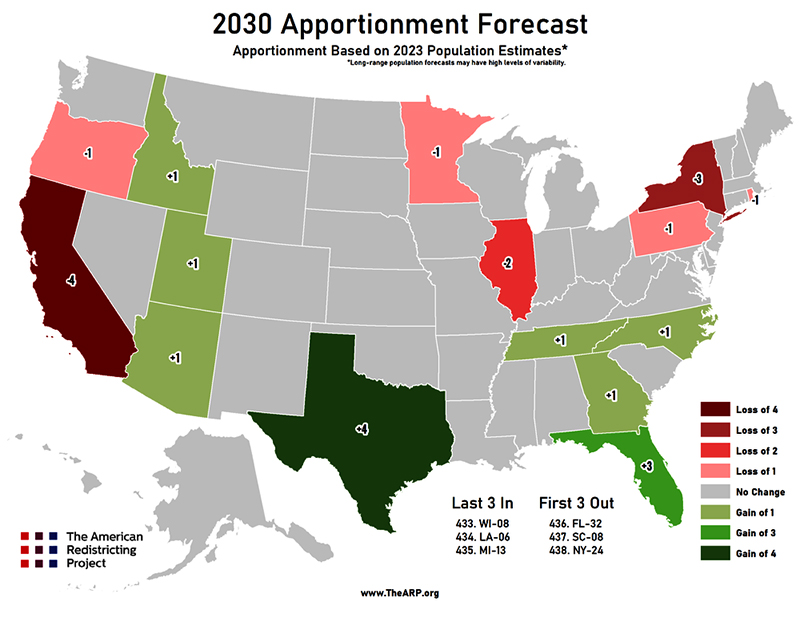

Every year, the Census Bureau releases its projections for the population at the next census. On Tuesday, the most recent one came out. There are 335 million people living in the U.S. now. The Bureau is projecting continuing migration from the Northeast and Midwest to the South. By the 2030 census, this is going to have a huge effect on the composition of the House and the Electoral College. Here are the projected changes from the current situation.

The effect is dramatic. The blue states are huge losers and the red states are winners. The two biggest losers are California (-4) and New York (-3). The biggest winners are Texas (+4) and Florida (+3). All in all, states that Joe Biden won in 2020 will lose 11 House seats and 11 electoral votes. States that Donald Trump won will gain 11 House seats and 11 electoral votes. Obviously, this appears to be very good news for the Republicans.
On closer inspection, the consequences are not quite so stark, however. Among the winners are Arizona, Georgia, and North Carolina. If the people coming there are coming from blue states—and according to the map, that is where they are coming from—they don't usually check their political views at the door when they enter. This means that all three states are likely to become bluer. If Arizona, Georgia, and North Carolina all become blue states, it will be much harder for Republicans to win presidential elections, even with Texas and Florida having seven more electoral votes. Flipping North Carolina alone will be worth 17 electoral votes for the Democrats. That more than makes up for all the other losses. Also, if Arizona and Georgia solidify as blue states, the Republicans are going to have a very hard time winning presidential elections.
If we ignore the possibility of any states flipping and just assume that all states in 2032 go the same way as they did in 2020, we get different electoral vote totals, of course. In 2020, the Democrat won 306 EVs and the Republican won 232 EVs. As a result of the 2020 census, if all the states go the same way in 2024 as they did in 2020, that will be 303/235 Democrat/Republican. With the new EVs projected for 2030, the Democrat will get 292 and the Republican will get 246 in the 2032 election, still a win for the Democrat. And if North Carolina flips, it becomes 309 for the Democrat and 229 for the Republican.
In the House, it is different. A small influx of Yankees into North Carolina gets the Democrats 17 electoral votes but not 17 new house seats. That depends very much on gerrymandering. In Texas and Florida, the seven new House seats will all be Republican unless gerrymandering is abolished by 2030. In North Carolina, the gerrymandering is severe enough that a small population change won't flip the badly gerrymandered state legislature. California uses an independent commission, but the Democrats have so many House seats that the four they lose are likely to be mostly or all Democratic seats. The New York legislature will try to make sure at least two of the lost seats are red seats.
One final note here. While North Carolina and Georgia are probably going to pick up people predominantly from the Northeast, Arizona is more likely to get folks from the Midwest, including many Republicans. Consequently, it may not go blue as fast as North Carolina and Georgia. And of course, it is 6 years before reapportionment kicks in, and a lot can change in 6 years. (V)